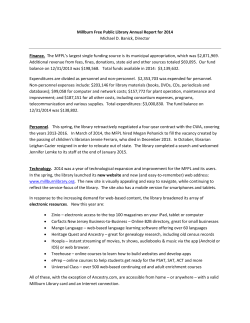
Activity Instructions, instructor notes and answer key
Instructions, Instructor Notes and Answer Key for Ocean Gyre Circulation and Patterns of Global Primary Productivity Instructions for activity: The instructions below are described for individual student participation. This activity could also be used in a small group format, but the groups should probably be no larger than 3 students for each student to really be involved. There is a single front and back handout that students get. The front has a schematic map of the north and south Atlantic Ocean with simplified circulation gyres in each ocean basin and the back has a north to south sea surface profile illustrating that the sea surface is not flat. Print one or two copies of handout for each student. Part 1- Map side. First, ask students to draw arrows on the circulation gyres that show the direction of Ekman transport and then have them compare their map to a neighbor’s map and discuss and similarities/differences. (5 min). Second, we come back to the full class and have someone come to the board or document camera and place their arrows on a blank map (or bring their map up to document camera). Ask class whose map is similar/different and their thoughts on why. Then, together as a class we tease out the correct placement of arrows and why. (7-10 min). Second, students are asked to write the words ‘divergence’ and ‘convergence’ in the locations on the map where each process occurs and to do the same with the words ‘upwelling’ and ‘downwelling’. They then again, compare their map to a neighbor’s and discuss similarities/differences. (5 min). Then we come back to the full class and someone comes to the board or document camera to place on the map their locations for the above processes (or bring their map up to document camera). Ask class whose map is similar/different and their thoughts on why, and then together we tease out the correct locations of where these processes occur and why. (7-10 min). Part 2 – Profile side. Using the other side of the schematic map, ask students to write ‘divergence’ and ‘convergence’ and ‘upwelling’ and ‘downwelling’ in the correct locations on the sea surface profile and compare with a neighbor. (5-7 min). Then with the sea surface profile on the board or document camera have student(s) indicate their locations of the above processes or have a student come up and write their locations on blank map or board (or bring their map up to document camera). Ask class whose profile is similar/different and their thoughts on why, and then together we tease out the correct locations of where these processes occur and why. (7-10 min). Part 3 – Primary Productivity. Now that students have a sense of the correct circulation patterns, ask them to write ‘high productivity’ and ‘low productivity’ in the locations where they think each of these occurs relative to the circulation patterns that they have outlined on both the map and the profile and have them compare with a neighbor. (5-7 min). Then follow same procedure as above with full class to tease out correct locations of high and low productivity and why. (10 min). At the completion of the exercise students are given another copy of the same blank handout with instructions that this is another opportunity to complete the map and the profile on their own as a way to self-monitor their progress on developing an understanding of ocean gyre circulation and the associated patterns of global productivity and to check that any earlier misconceptions have been corrected. This can be turned in for a grade or can be an ungraded assignment that will be extremely useful in preparing for upcoming exams. It is the act of having the students annotate the figures themselves ( and more than once) along with the student-student discussion and full class discussion that really allows them to anchor these relationships to their prior knowledge of ocean circulation, processes involved is creating it and its impact on global patterns of productivity. Instructor Notes: The notes below include information on necessary prior knowledge, places where misconceptions are common, sticky points for student understanding, This activity works best if done after the following topics have been covered in class: air masses, pressure systems, atmospheric circulation, wind and surface circulation patterns, eastern and western boundary currents, geostrophic flow and movement of water into or away from circulation gyres, Ekman spiral and transport and a basic introduction to primary productivity as production of organic matter by algae via photosynthesis (probably done in discussions of dissolved gases and nutrients during marine chemistry or properties of water topics). The times noted for each part of the activity are estimates, sometimes they could be much shorter or longer depending on which or how many concepts students seem to need a review on as the whole class discussion of the map and profile proceeds The first place that misconceptions or misunderstanding arises is when students are asked to place arrows on the circulation gyre. The most common error is arrows placed on the outside of the gyres rather than on the inside. Also, sometimes students place the arrows inside but at 90o to the surface circulation instead of just deflecting them a bit to the right or left depending on hemisphere. Ekman transport is 90o to the direction of the wind, not to the surface circulation. Students often have a difficult time grasping that the sea surface is not flat, that water piles up in places, which is why the profile part of the exercise is important and works. It really helps them to understand why there is sea surface topography, what it looks like and where it is, and what the implications of it are. The activity could be extended to include coastal upwelling, downwelling (due to movement of surface waters toward or away from the coast) and productivity, as well, however getting the large-scale circulation and productivity patterns down cold first works best. Doing it all together sometimes get students confused. In addition, this activity can be tied back to the distribution of deep sea sediments in that the siliceous oozes are found in equatorial and polar high latitude regions of high primary productivity. Providing students with this connection always makes their heads spin because they thought they were done with marine sediments. This provides another teachable moment on the interdisciplinary nature of oceanography.
© Copyright 2025









